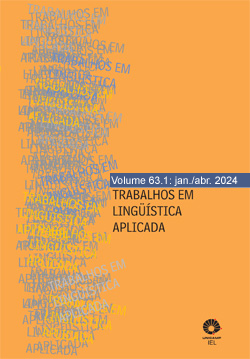Abstract
Working with literature in the classroom is at the same time a rich and complex activity, especially as it launches the learner into a poetic, sociological, political, historical and cultural universe that serves as access to the pleasurable study of a foreign language. It is in this context, in the sense of combining literature and translation, that pedagogical translation is inserted, considered here as a means of communication and culture, which aims to reconcile proficiency with linguistic reflection. For this research, with students in the 2nd phase of a Spanish Literature course, pedagogical translation activities were analyzed, designed to reflect on the language and to learn it. The activities, carried out virtually in the Moodle environment, were based on seven short stories by different writers distributed over the course's seven modules. They are: La obra y el poeta (by the British Richard Francis Burton), El gesto de la muerte (by the French Jean Maurice Cocteau), Infinito (by the Argentine Ernesto Sábato), La obra maestra (by the Argentine Álvaro Yunque), Una pequeña fábula (by the Czech Franz Kafka), El pozo (by the Spanish Luis Mateo Díez), El loco (by the Spanish Jordi Cebrián). Each pedagogical translation activity with the microstories was divided into three parts: the 1st consisted of a careful reading of the small text, where some words were highlighted, to, afterwards, select the correct alternatives in relation to the highlighted words, which should be searched. The options offered ranged from five to ten, according to the complexity of the text, and were related to the lexicon. The intention, in that 1st moment, was to give clues to the learner/reader that would help him in the comprehension process and in the future translation. The 2nd part offered a brief biography of the writer, to be read, followed by the translation activity of the text. Finally, in the 3rd part, there was a space for them to expose their doubts and challenges regarding the words and/or sentence structures. That is, a moment destined to reflect on the translation act. The data results show the linguistic reflection elaborated by the learners in their foreign language learning process.
References
ARRIBA GARCÍA, Clara de. (1996) Introducción a la traducción pedagógica. Lenguaje y textos, v. 8, p. 269-283.
BERGMANN, Juliana Cristina Faggion; CESCO, Andréa. Legendar para aprender língua estrangeira. CESCO, Andréa; ABES, Gilles; BERGMANN, Juliana CF (org.). Teoria e prática da tradução: lengendagem, HQ, textos técnicos e científicos. Florianópolis: Rafael Copetti Editor, 2019.
CARRERES, Ángeles; NORIEGA-SÁNCHEZ, María. (2019) Traducción Pedagógica (Pedagogical translation). Em: MUÑOZ-BASOLS, Javier; GIRONZETTI, Elisa; LACORTE, Manoel (org.) The Routledge Handbook of Spanish Language Teaching: Metodologías, contextos y recursos para la enseñanza del español L2. New York: Routledge.
CARRERES, Ángeles; MUÑOZ-CALVO, Micaela; NORIEGA-SÁNCHEZ, María. (2017) Translation in Spanish language teaching: the fifth skill/La traducción en la enseñanza del español: la quinta destreza. Journal of Spanish language teaching, v. 4, n. 2, p. 99-109. https://doi.org/10.1080/23247797.2017.1419030
CESCO, Andrea; BERGMANN, Juliana Cristina Faggion. A tradução pedagógica no ensino de espanhol como língua estrangeira. Em: CANCELA JÚNIOR, Joaquim Martins; NASCIMENTO, Lilian Cristina Barata Pereira; PINTO, Antonio Sergio da Costa (org.) Estudos da Tradução: Caminhos. Campinas, SP: Pontes Editores, 2023. (Coleção Estudos da Tradução, v. 15)
COLINA, Sonia; LAFFORD, Barbara A. (2017) Translation in Spanish language teaching: the integration of a “fifth skill” in the second language curriculum. Journal of Spanish Language Teaching, v. 4, n. 2, p. 110-123. https://doi.org/10.1080/23247797.2017.1407127
CONSELHO DA EUROPA (2001) Quadro Europeu Comum de Referência para as Línguas - Aprendizagem, ensino, avaliação. Lisboa: Edições ASA. Colecção perspectivas actuais | educação.
CORRÊA, Elisa F. de Souza. (2014) Sobre a necessidade de tradução pedagógica na aula de Língua não materna: quinta habilidade e macroestratégias. Revista de Letras, v. 33, n. 2, jul/dez, p. 53-64.
CORRÊA, Elisa F. de Souza. (2017) A tradução pedagógica: experimentos e exercícios para uso em aula. Revista EntreLinguas, v. 3, n.2, p. 179–202. https://doi.org/10.29051/rel.v3.n2.2017.9225
CUÉLLAR LÁZARO, Carmen. (2004) Un nuevo enfoque de la traducción en la enseñanza comunicativa de las lenguas. Revista Hermeneus. Revista de Traducción e Interpretación, n.6. Soria. ISSN: 1139-7489. https://dialnet.unirioja.es/servlet/articulo?codigo=1027635
DUFF, Alan. (1989) Translation. Oxford: Oxford University Press.
GARCÍA YEBRA, Valentín. (1998) la traducción en la enseñanza de las lenguas afines. Em: CALVI, Vittoria; SAN VICENTE, Félix (org). La identidad del español y su didáctica. Viareggio: Baroni Editores.
HUMBLÉ, Philippe; LUCINDO, Emy Soares. (2014). Língua Espanhola II. Florianópolis: LLE/CCE/UFSC.
HURTADO ALBIR, Amparo. (1994) Un nuevo enfoque de la traducción en la didáctica de las lenguas. Traducción, Interpretación, Lenguaje. Actas III Congreso Internacional Expolingua: Madrid, p.67-89.
LAVAULT, Elisabeth. (1985) Fonction de la traduction en didactique des langues, Collection Traductologie, no.2. Paris: Didier Érudition.
LESKE, Irene Prüfer. (2012) La traducción literaria. Prefácio de Humberto L. Morales. Estudo preliminar de Christiane Nord. Valencia (España): Aduana Vieja Editorial.
NAIMUSHIN, Boris. (2002) Translation in Foreign Language Teaching: The Fifth Skill. Modern English Teacher, v. 11, n. 4, p. 46-49.
NOAL, Joselma M., VAZ, Artur E. A., & PILLETI, Daniele C. (2017). A tradução literária no ensino de línguas. Revista EntreLinguas, v. 3, n. 2, p. 318 – 335. DOI: https://doi.org/10.29051/rel.v3.n2.2017.9410
PYM, Anthony. (2018) Where Translation Studies lost the plot: Relations with language teaching. Translation and Translanguaging in Multilingual Contexts, v. 4, n. 2, p. 203 - 222. https://doi.org/10.1075/ttmc.00010.pym
PYM, Anthony; MALMKJAER, Kirsten; GUTIÉRREZ-COLÓN PLANA, Mar (2013). Translation and Language Learning: The role of translation in the teaching of languages in the European Union. A Study. Luxembourg: Publications Office of the European Union. https://doi.org/10.2782/13783.
TAKIMOTO, Masato; HASHIMOTO, Hiroko (2010) An “Eye-Opening” Learning Experience: Language Learning through Interpreting and Translation. Electronic Journal of Foreign Language Teaching, v. 7, n. 1, p. 86–95.
ZIMANYI, Krisztina. (2017). Caminhos para o ensino de tradução na aula de língua estrangeira: uma proposta para a tradução audiovisual de Coraline em aulas de inglês como LE/ESOL. Revista EntreLinguas, v. 3, n. 2, p. 336 – 351. DOI: https://doi.org/10.29051/rel.v3.n2.2017.9427

This work is licensed under a Creative Commons Attribution 4.0 International License.
Copyright (c) 2023 Juliana Cristina Faggion Bergmann, Andréa Cesco


